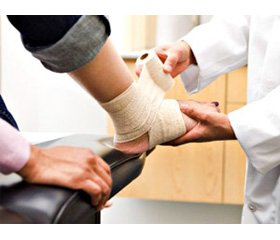Журнал «Боль. Суставы. Позвоночник» 2 (18) 2015
Вернуться к номеру
Injury of Musculoskeletal System in Young Patients with Undifferentiated Connective Tissue Dysplasia
Авторы: Osypenko I., Solyeyko O., Soleyko L. - Vinnytsia National Pyrogov Medical University, Vinnytsia, Ukraine
Рубрики: Ревматология, Травматология и ортопедия
Разделы: Медицинские форумы
Версия для печати
Статья опубликована на с. 92-93
Introduction. Problem of undifferentiated connective tissue dysplasia (UCTD) as pathology of collagen, is a significant problem of modern medicine because of the high prevalence, multiorgans injury and serious affects. Congenital defects of connective tissue can be diagnosed at the stage of physical examination of the patient at combined rating of phenotypic markers. Thus, a big numbers of external markers of dysplasia are founded at UCTD. Prevalence of some external phenotypes according to various sources is extremely high: single external markers detected in 94 % of young people, numerous (more than 6 features) ones are found in 42 % of patients. The most studied and dangerous for the complications at the syndrome of UCTD is idiopathic mitral valve prolapse (MVP), which often occurred with cardiac arrhythmias. At the same time, injury of the thoracic spine at UCTD causes to arrhythmic complications of vertebrogenic character.
The aim of our study was to find external (phenoty–pic) markers of UCTD from the side of musculoskeletal system in patients with idiopathic MVP and detect prognostically important parameters for further formation of risk groups.
Materials and methods. We examined 120 patients of age 16 to 35 years with idiopathic MVP (average age — 25.1 ± 0.4 years). All patients had a complex clinical and instrumental examination (general clinical, biochemical, ECG, Holter ECG monitoring, Doppler echocardiographic examination, X–ray examination). Somatometric examination of the patients conducted by the method of V.V. Bunaka (1939, 1941) in modification of P.P. Shaparenko (1989).
Results. By the study results 100 % of patients had the skeletal system injury regardless of the degree of MVP. However, the evidences of a musculoskeletal system injury differed depending on the degree of MVP. Thus, the phenotypic markers of the spine (scoliotic curvature, kyphoscoliosis, straight back and hollowed chest) significantly more often detected in patients with II degree of MVP (p < 0.05). Phenotypic stigmas of the upper and lower extremities (short and crooked little finger, «like sandal» cleft foot, flat feet, dolichostenomielia) were founded in the same number of patients regardless of the degree of MVP (64.1 %). Changes of the oral cavity (abnormalities of dentition structure, high palate) were found in 52.1 % of patients with idiopathic MVP. Hypo–trophy (61.4 %) often was observed among stigmas muscle in patients with idiopathic mitral valve prolapse, incidence of which was increased significantly with the degree of MVP (p < 0.05).
Cardiac rhythm disorder was observed in 51 patients (42.5 %). Supraventricular extrasystole, sinus tachycardia, ventricular arrhythmia dominated among the patients with I degree of MVP. Supraventricular extrasystole, paroxysmal supraventricular tachycardia, ventricular extrasystole, sinus tachycardia, fibrillation were registered in patients with II–III degree of MVP more often. Correlation analysis revealed a strong direct connection between the degree of MVP and the numbers of musculoskeletal stigmas (r = +0.72). Risk assessment in the form of calculating the odds ratio (OR) in patients with II–III degree of MVP showed that the probability of arrhythmic disorders they may have in 6.3 times higher than in patients with I degree of MVP (OR = 6.3). On this base we select the group of patients with high risk of arrhythmic complications of idiopathic MVP: young men with II–III degree of MVP and the presence of 4 or more musculoskeletal dysembriogenesis stigmas.
Conclusions. Thus, UCTD syndrome is a unique abnormal background for the existence of various clinical conditions with a wide range of symptoms. Early detection and correction of phenotypic markers of UCTD from the side of the musculoskeletal system will improve the quality of life of such patients and reduce possibility of disability in a future.

